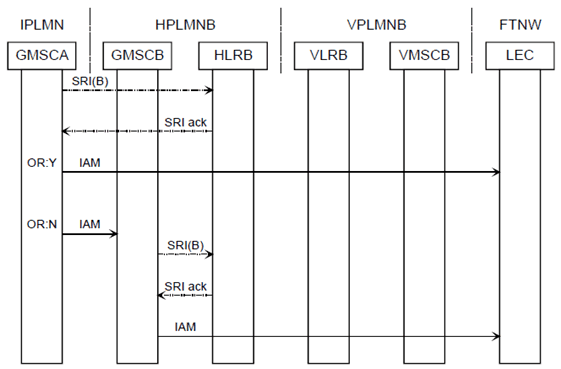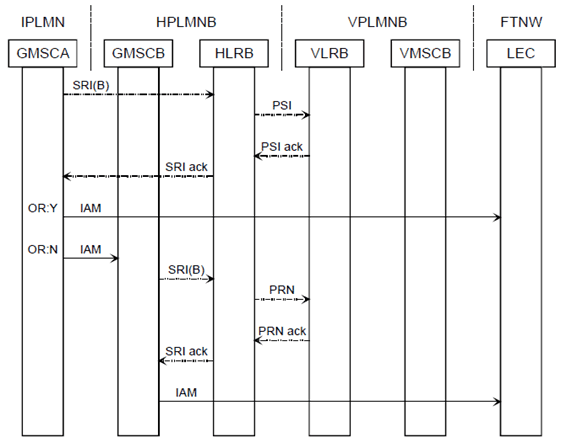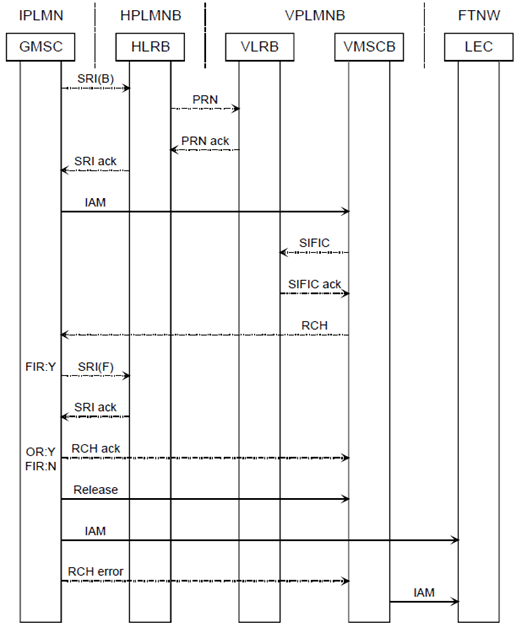Content for TS 23.079 Word version: 18.0.0
6 Optimal routeing for conditional call forwarding: message flows
6.1 Early call forwarding
6.1.1 Forwarding without interrogation of VLRB
6.1.2 Forwarding after interrogation of VLRB
6.2 Late call forwarding
6.2.1 Successful outcome
6.2.2 Unsuccessful outcome
...
...
6 Optimal routeing for conditional call forwarding: message flows p. 13
The description in this clause of the handling of optimal routeing for conditional call forwarding is informative, not normative. Further, the description does not consider the effects of other services or features, except where these are specifically mentioned.
Two cases of conditional call forwarding are described in this clause:
- early call forwarding to a fixed destination;
- late call forwarding to a fixed destination.
6.1 Early call forwarding p. 13
Early call forwarding is defined as call forwarding from the IPLMN before the call has been extended to the VPLMN of the forwarding subscriber. CFU and CFNRc when the forwarding mobile subscriber is IMSI detached are examples of early call forwarding. Early call forwarding is effectively optimally routed, because the call takes the most direct route possible from the IPLMN to the forwarded-to destination.
The message flows for early call forwarding to a fixed destination are shown in figure 4a (forwarding without VLR interrogation) and figure 4b (forwarding after VLR interrogation). The IPLMN is shown as distinct from HPLMNB, on the assumption that the original call towards the B subscriber was optimally routed; however if optimal routeing of basic mobile-to-mobile calls is not implemented, the IPLMN will be the same as HPLMNB. Solid lines indicate circuit-associated signalling; dashed lines indicate connectionless signalling.
6.1.1 Forwarding without interrogation of VLRB p. 13
6.1.1.1 Successful outcome p. 13
GMSCA sends a request for routeing information (SRI(B)) to HLRB. If HLRB determines that the call is to be forwarded without needing to signal to VLRB then HLRB returns the forwarded-to number (FTN) in the SRI ack.
If GMSCA determines that the call can be forwarded to LEC without contravening the charging requirements for Support of Optimal Routeing given in clause 9.1 (decision OR:Y) it constructs an ISUP IAM using the FTN and sends it to LEC.

Figure 4a: Message flow for early call forwarding to a fixed destination - forwarding without interrogation of VLRB
(⇒ copy of original 3GPP image)
(⇒ copy of original 3GPP image)
6.1.1.2 Unsuccessful outcome p. 14
Error situations which lead to failure of the call, rather than non-optimal routeing, are not described in this clause.
If GMSCA determines that the call cannot be forwarded to LEC without contravening the charging requirements for Support of Optimal Routeing given in clause 9.1 (decision OR:N) it constructs an IAM using the B subscriber address and sends it to GMSCB.
GMSCB sends a request for routeing information (SRI(B)) to HLRB. If HLRB determines that the call is to be forwarded, as described in clause 6.1.1.1, it returns the FTN in the SRI ack.
GMSCB constructs an IAM using the FTN and sends it to LEC.
6.1.2 Forwarding after interrogation of VLRB p. 14
6.1.2.1 Successful outcome p. 14
GMSCA sends a request for routeing information (SRI(B)) to HLRB. HLRB sends a request for the subscriber status (PSI) to VLRB. If the record in VLRB for the B subscriber shows that the B subscriber is IMSI detached, VLRB indicates this in the PSI ack. Alternatively, if HLRB determines that at least one of the three conditions:
- the GMSC is in the same country as VMSCB;
- the HLR is in the same country as VMSCB;
- the GMSC is in the same PLMN as the HL;

Figure 4b: Message flow for early call forwarding to a fixed destination - forwarding after interrogation of VLRB
(⇒ copy of original 3GPP image)
(⇒ copy of original 3GPP image)
6.1.2.2 Unsuccessful outcome p. 15
Error situations which lead to failure of the call, rather than non-optimal routeing, are not described in this clause.
If GMSCA determines that the call cannot be forwarded to LEC without contravening the charging requirements for Support of Optimal Routeing given in clause 9.1 (decision OR:N), it constructs an ISUP IAM using the B subscriber address and sends it to GMSCB.
GMSCB sends a request for routeing information (SRI(B)) to HLRB. HLRB sends a request for a roaming number (PRN) to VLRB. If the record in VLRB for the B subscriber shows that the B subscriber is IMSI detached, VLRB indicates this in the PRN ack. If HLRB determines that CFNRc should be invoked, it returns the forwarded-to number (FTN) in the SRI ack.
GMSCB constructs an IAM using the FTN and sends it to LEC.
6.2 Late call forwarding p. 16
Late call forwarding is defined as call forwarding after the call has been extended to the VPLMN of the forwarding subscriber. CFB, CFNRc on no response to paging and CFNRy are examples of late call forwarding. In the absence of OR, late call forwarding occurs in the VPLMN of the forwarding party; if OR applies, late call forwarding occurs in the IPLMN.
The message flow for optimal routeing of late call forwarding to a fixed destination is shown in figure 5. The IPLMN may be distinct from HPLMNB or the same as HPLMNB, depending on whether or not the original call to VPLMNB was optimally routed, but this description assumes that the original call to VPLMNB was optimally routed. For simplicity of description, the separation of VMSCA and GMSCA (described in clause 5 & clause 6.1) is omitted. Solid lines indicate circuit-associated signalling; dashed lines indicate connectionless signalling.

Figure 5: Message flow for optimal routeing of late call forwarding to a fixed destination
(⇒ copy of original 3GPP image)
(⇒ copy of original 3GPP image)
6.2.1 Successful outcome p. 17
The GMSC obtains a roaming number from HLRB to route the call to VMSCB, as described in clause 5.1. The SRI ack also includes an indication of whether the GMSC should interrogate the HLR for routeing information for late call forwarding. The GMSC constructs an IAM using the roaming number, and sends it to VMSCB. When VMSCB receives the IAM, it requests subscriber information for the incoming call (SIFIC) from VLRB. If VLRB determines that the call should be forwarded, because the called mobile subscriber is busy, or is not reachable, or has not replied to the call before the no-reply call timer has expired, it returns a SIFIC ack containing the forwarded-to number, the forwarding reason, the GMSC address and the call reference number to VMSCB. VMSCB sends a request to resume call handling (RCH) to the GMSC; the RCH includes the forwarded-to number, the forwarding reason and the basic service information received in the SIFIC ack.
If the HLR indicated in the SRI ack which contained the MSRN that the GMSC should interrogate the HLR for forwarding information (FIR:Y), the GMSC then sends a request for forwarding information (SRI(F)), containing the forwarding reason and the basic service group which applies for this call, to HLRB. HLRB responds with the appropriate forwarded-to number.
If the HLR indicated in the SRI ack which contained the MSRN that the GMSC should not interrogate the HLR for forwarding information (FIR:N), the GMSC checks the forwarded-to number received in the RCH.
If the GMSC determines that the call can be forwarded to the forwarded-to destination without contravening the charging requirements for Support of Optimal Routeing given in clause 9.1 (decision OR:Y) it:
- sends an RCH ack to VMSCB to indicate that control of the call has been accepted;
- sends an ISUP Release message indicating normal clearing to VMSCB to release the traffic circuit;
- constructs an IAM using the forwarded-to number, and sends it to LEC.
6.2.2 Unsuccessful outcome p. 17
Error situations which lead to failure of the call, rather than non-optimal routeing, are not described in this clause.
6.2.2.1 GMSC does not support OR p. 17
If the GMSC does not support OR, it omits the 'or-capability' information element from the SRI(B) request. The HLR then sends the 'OR not supported in GMSC' indicator in the PRN to VLRB. VMSCB will not send the RCH to the GMSC if the 'OR not supported in GMSC' indicator was received in the PRN. Instead, the call will be forwarded at VMSCB.
6.2.2.2 HLRB does not support OR p. 17
If HLRB does not support OR, it does not relay the GMSC address and the call reference number which it received in the SRI(B), so VMSCB cannot send the RCH to the GMSC. Instead, the call will be forwarded at VMSCB.
6.2.2.3 VMSCB/VLRB does not support OR p. 17
If VMSCB/VLRB does not support OR, VMSCB cannot send the RCH to the GMSC. Instead, the call will be forwarded at VMSCB.
6.2.2.4 OR charging requirements contravened p. 17
If the original call to VMSCB was optimally routed, the GMSC can route the call to the forwarded-to destination only if the charge to do so is no more than the charge to route the call to HPLMNB. If this requirement, determined as described in clause 9.1, is not met (decision OR:N) the GMSC returns an RCH negative response (shown in figure 5 as 'RCH error') to VMSCB, which then forwards the call.
If the original call to VMSCB was not optimally routed, the GMSC can route the call directly to the forwarded-to destination only if the charge to do so is no more than the charge for the routeing to VMSCB. If this requirement, determined as described in clause 9.1, is not met (decision OR:N) the GMSC returns an RCH negative response (shown in figure 5 as 'RCH error') to VMSCB, which then forwards the call.